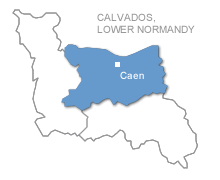Caen - the heart of Lower Normandy
Caen is these days one of the most attractive and accessible places to visit in northern France. It is situated close to ferry ports, located at the heart of a good motorway network and offers plenty to see and do both in the city and in the surrounding region.
Talking of regions, Caen is the capital of Lower Normandy. Back in the days of William the Conqueror the town had been promoted as an administrative and cultural centre and it retains that role today, both with the regional administration, the major historic sites and the local university.

This part of France has always had a strong agricultural tradition and links to the sea through the English Channel (or La Manche, as the French would call it). The local cuisine features much regional produce: Caen is also the prefecture of the Calvados administrative area (Calvados is the famous French apple brandy from the region) and butter, alcohol and cream feature in the rich local recipes. However those of a tender disposition might do well to avoid another speciality: 'tripes à la mode de Caen'.
The dish, supposedly created by a monk from the Abbaye-aux-Hommes in the Middle Ages, consists of a stew of the four separate stomachs of a cow along with a trotter.
How do I pronounce Caen?
The answer is: with some difficulty if you don't speak French with a decent accent already. If you know the French word 'quand' already, it would be very similar (apart from the 'd' sound which sometimes appears before the next word). Try to think of the first part of the English word 'condiment' but in a French accent. If you say the section 'con' with too much of an English accent (in other words, shorter and harder) it becomes quite a strong French insult!
Where does the name Caen come from?
There are many stories and theories about the origins of the name Caen, probably due to the fact that many different versions were used in official documents of the Dukes of Normandy. The most popular answer seems to be that the current name eventually evolved from a longer conjunction of two Celtic words meaning 'battle' and 'plain'. By the 15th century, 'Caen' was in common usage along with the Latin version 'Cadomus'.
Caen and the UK
The whole area near the coast is connected historically to the UK. After all, the Bayeux tapestry commemorates the invasion of England by William the Conqueror (who is responsible for some of the most important sites in Caen).
After that Norman invasion (1066 is possibly engraved in the minds of most English schoolchildren) the city was also fought over during the suitably-named Hundred Years' War.
The Battle of Caen was one of the first engagements of a 14th-century invasion by the English and the capture of Caen led to a massacre of around half the inhabitants and, eventually, to foreign control of this part of France for the next 200 years.
The Battle for Caen took place after the Normandy beach landings in 1944. Originally the plan had called for Caen to be captured in the first advance off the beachheads and the capture of the strategic bridge over the Orne at Ouistreheim (the port of Caen) was one of the first actions of D-Day.
However a strong counter-attack led to a long stalemate around the Caen region. It was finally captured just over a month later at the cost of many civilian deaths and the destruction of much of the city through aerial bombardment.
Caen Facts and Figures
Caen is the capital of Lower Normandy and is actually the second-largest town in the region, with a slightly larger population (ca. 113,000) than its Upper Norman neighbour Rouen. (Le Havre, which is the capital of neither departement, is actually the largest city by quite a long way.) All three cities however have a larger urban area surrounding them.

Caen is also the prefecture of Calvados, one of the three Lower Norman departements. It is twinned with Würzburg in Germany (the city council deliberately decided to choose a German town as the first partner in a spirit of post-War reconciliation).
In the meantime, it also has twinning arrangements with the town of Portsmouth in the UK and Nashville, Tennessee and Alexandria, Virginia, in the USA (as well as other eastern European and African cities).


